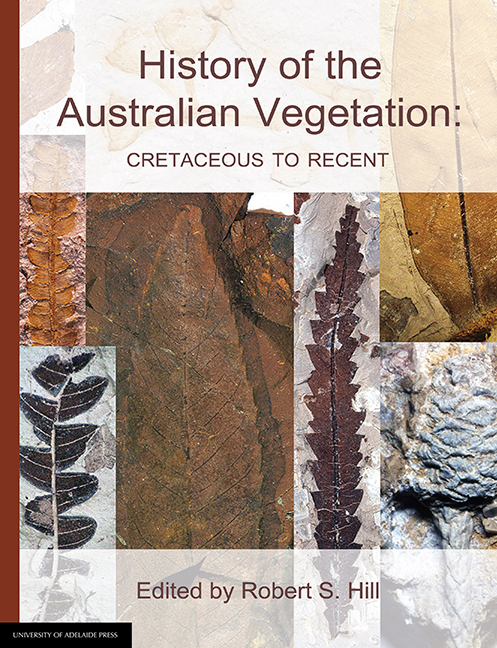Book contents
- Frontmatter
- Contents
- List of contributors
- Introduction to the 2017 edition
- 1 The Australian fossil plant record: an introduction
- 2 Maps of late Mesozoic-Cenozoic Gondwana break-up: some palaeogeographical implications
- 3 The background: 144 million years of Australian palaeoclimate and palaeogeography
- 4 Palaeobotanical evidence for Tertiary climates
- 5 Landscapes of Australia: their nature and evolution
- 6 Patterns in the history of Australia's mammals and inferences about palaeohabitats
- 7 Australian Tertiary phytogeography: evidence from palynology
- 8 Cretaceous vegetation: the microfossil record
- 9 Cretaceous vegetation: the macrofossil record
- 10 Early Tertiary vegetation: evidence from spores and pollen
- 11 The early Tertiary macrofloras of continental Australia
- 12 Cenozoic vegetation in Tasmania: macrofossil evidence
- 13 The Neogene: a period of transition
- 14 The Oligo-Miocene coal floras of southeastern Australia
- 15 Quaternary vegetation
- 16 The history of selected Australian taxa
- Taxonomic index
- General index
5 - Landscapes of Australia: their nature and evolution
Published online by Cambridge University Press: 25 July 2017
- Frontmatter
- Contents
- List of contributors
- Introduction to the 2017 edition
- 1 The Australian fossil plant record: an introduction
- 2 Maps of late Mesozoic-Cenozoic Gondwana break-up: some palaeogeographical implications
- 3 The background: 144 million years of Australian palaeoclimate and palaeogeography
- 4 Palaeobotanical evidence for Tertiary climates
- 5 Landscapes of Australia: their nature and evolution
- 6 Patterns in the history of Australia's mammals and inferences about palaeohabitats
- 7 Australian Tertiary phytogeography: evidence from palynology
- 8 Cretaceous vegetation: the microfossil record
- 9 Cretaceous vegetation: the macrofossil record
- 10 Early Tertiary vegetation: evidence from spores and pollen
- 11 The early Tertiary macrofloras of continental Australia
- 12 Cenozoic vegetation in Tasmania: macrofossil evidence
- 13 The Neogene: a period of transition
- 14 The Oligo-Miocene coal floras of southeastern Australia
- 15 Quaternary vegetation
- 16 The history of selected Australian taxa
- Taxonomic index
- General index
Summary
It is oft said that ‘Australia is an old continent’. Certainly Australia has many ancient landscapes which have been exposed to the processes of weathering and soil formation for very long periods under very stable tectonic conditions. The results of this are that many of our landscapes have well-leached and infertile soils, a major factor in the evolution of the Australian flora. Having said that, it is not true that all Australian landscapes are ancient. Many are very young, and of course all our landscapes are still undergoing modification, albeit some very slowly. Many landscapes that were thought to be comparatively young, such as the Southeastern Highlands (Andrews, 1911; Browne, 1969; Hill, 1975), have recently been shown to be comparatively ancient (Wellman, 1987; Bishop, 1988; Taylor et al., 1990a).
The Australian continent attained its present outline between 150 and 50 million years (Ma) ago (Wilford & Brown, Chapter 2, this volume), but many of our landscapes are even older. Comparison of the major landform regions (Figure 5.1) and the major geological structure of the crust or tectonic provinces (Figure 5.2) demonstrates this well.
The tectonic provinces of Australia can be divided into two along the Tasman Line (Figure 5.2; Veevers, 1984). West of this line the continent is dominated by Precambrian blocks and fold belts overlain by thin Phanerozoic basins, while to the east of it there are mainly Phanerozoic fold belts overlain by younger basins. Broadly these fundamental geological divisions correspond to landscape regions. The Precambrian blocks correspond to plateaux at elevations of up to about 500 m, the fold belts to upland areas up to 2000 m and the basins to lowland plains with elevations of generally less than 200-300 m (Figure 5.3). The distinction between these major landform regions is reflected in the present drainage networks. Most integrated drainage occurs along the coastal margins, particularly along the eastern Phanerozoic fold belt. The drainage systems in the western parts of the continent are, however, generally uncoordinated.
- Type
- Chapter
- Information
- History of the Australian VegetationCretaceous to Recent, pp. 60 - 79Publisher: The University of Adelaide PressPrint publication year: 2017



